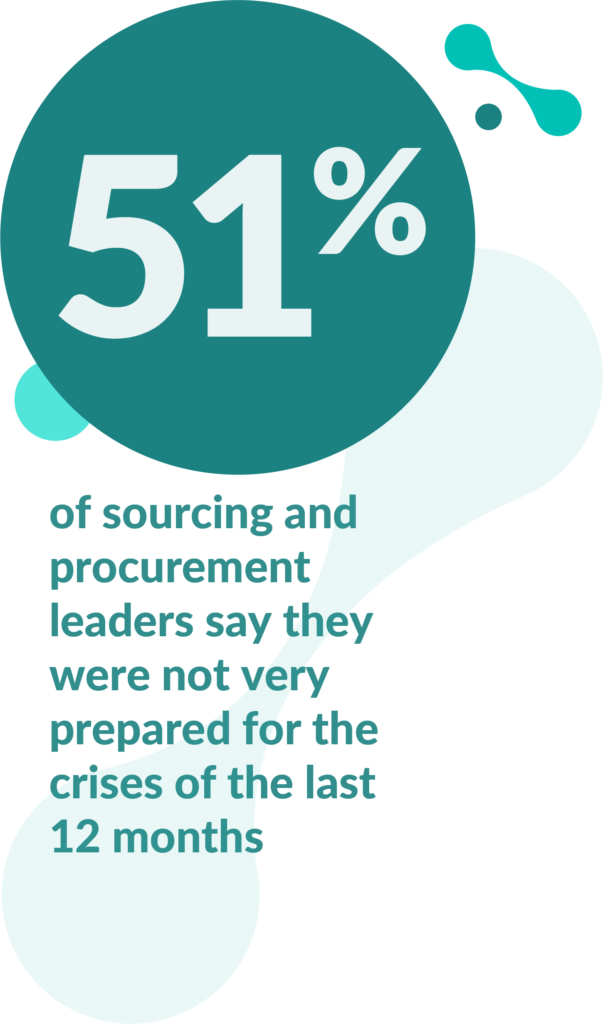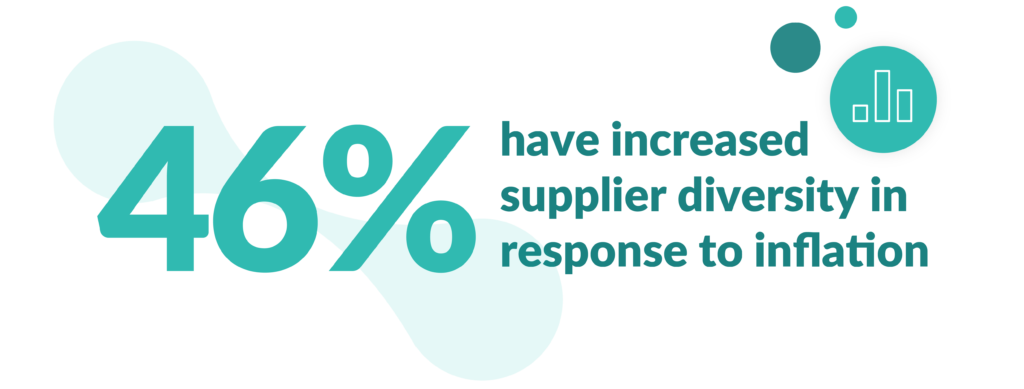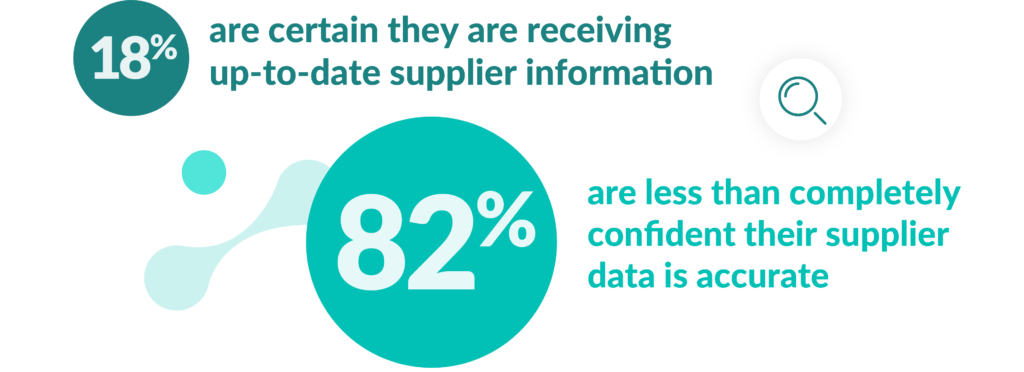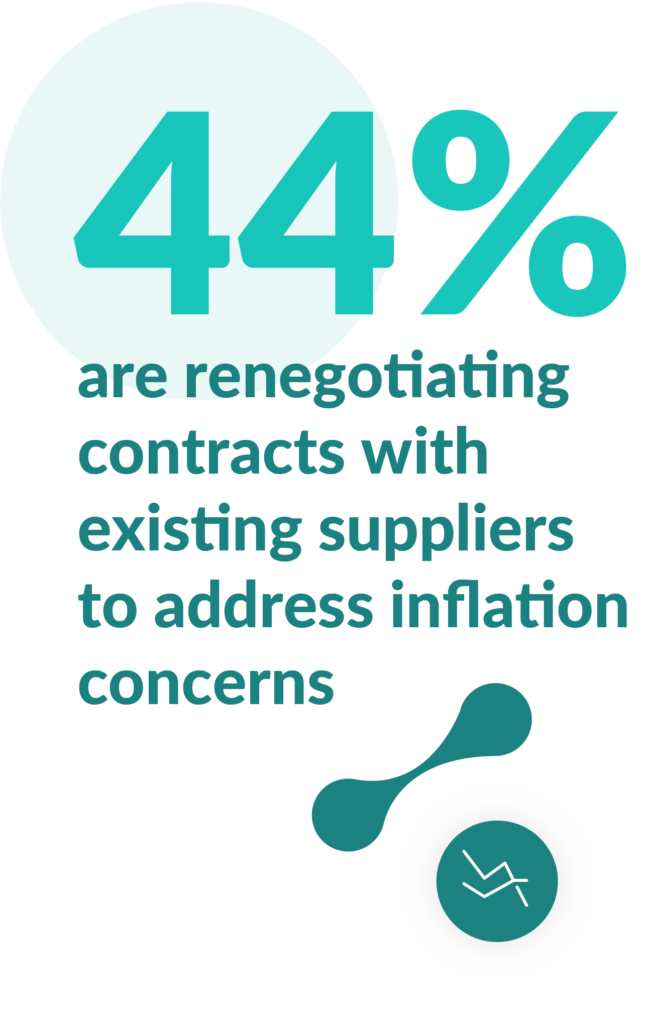As the procurement industry continues to battle new challenges and disruptions, TealBook partnered with Wakefield Research to gauge industry sentiment to deliver actionable insights reflective of procurement and sourcing professionals’ own experiences.
In this third-annual supplier information research initiative, we examine:
- Ongoing challenges of the procurement landscape
- Current state of confidence the industry has in their supplier data
- Prioritization of data by industry professionals
- Actionable steps sourcing leaders can take to improve supply chain agility and innovation
Broken down by section below, you can browse by topic to see exactly how your peers are feeling in the wake of the latest disruptions and how the industry, as a whole, agrees that improving access to strong supplier data holds the key to driving supply chain success.
- Executive Summary
- Key Findings
- Section 1: Intelligence Central
- Spotlight: Seeking Suppliers
- Section 2: Defeating Disruptions With Data
- Spotlight: Inflation
- Section 3: Agility, Diversity, Innovation—and Beyond
- Spotlight: ESG Visibility
- Final Thoughts
If you’d like to save this resource, enter your email below for an instant download.
Executive Summary
This year, even the most prepared companies were tested by the disruptions that continue to plague the supply chain. Challenges relentlessly multiplied into a cascade of ruptures that shook the foundation of how the world does business. Sourcing and procurement leaders realized that in the long run, being agile is more important than cost savings to the company’s bottom line.
But understanding agility’s importance is very different from utilizing it amid ongoing disruptions, including COVID lockdown measures, inflation, and labor shortages, uncovering an industry still struggling to prepare for the next crisis. In fact, a majority (51%) say they could have been better prepared for the disruptions of the last 12 months. And more than 1 in 3 (37%) admit that even the most agile companies would be disrupted by these crises, revealing that the supply chain disturbances were nevertheless too much for even the most prepared companies.
Looking forward, sourcing and procurement leaders face the challenges of navigating a new supply chain management landscape. To overcome these challenges, they must innovate to ensure the correct goods arrive on time and on budget, requiring a partnership with suppliers based on accurate data, transparency, and urgency.
The insights in this research were revealed in a survey of 200 sourcing and procurement executives at companies with $200 million or more in annual revenue, conducted by Wakefield Research for TealBook.

Key Findings
- Despite recognizing the importance of agility, 51% of sourcing and procurement leaders say they were not very prepared for the crises of the last 12 months.
- While 37% believe these crises would have affected even the most prepared organization, 63% believe agile teams better weathered the challenges – underscoring the vital importance of agility.
- Reflecting an inefficient process, sourcing and procurement leaders spent an average of nearly 5 weeks searching for a new supplier—and 100% had negative consequences due to sourcing delays.
- Nearly 2 in 3 (64%) recognize that accurate and up-to-date supplier data allows them to quickly source materials during a crisis.
- With data in mind, 100% cite benefits of enabling a supplier data foundation: a centralized system of supplier management that enables a business to cross-functionally increase the overall value of each channel’s activities.
- This means better service and a better bottom line: 41% cite limiting disruptions for customers as a top benefit of enabling a supplier data foundation, while 38% say it reduces overall costs.
- The most cited benefit of enabling a supplier data foundation is improving supplier diversity, as 51% recognize its importance.
- With a new challenge upon us, 46% have increased supplier diversity in response to inflation.
- Accessing a wide range of suppliers is and will remain crucial for companies’ futures, with 99% agreeing that supplier diversity is essential for innovation.

Intelligence central
For sourcing and procurement leaders, the ability to ensure that the right goods arrive at the right place on time is paramount. And pivotal to the success of this initiative in times of disruption is agility. They need expedient and definitive data to ensure they are partnering with the right suppliers to complete the job. Nearly 2 in 3 sourcing and procurement leaders (64%) note that accurate and up-to-date supplier data allows them to quickly source materials. Moreover, leaders recognize that the benefits extend beyond crises. This includes improving real-time analytics (52%) and identifying market trends and forecasts (51%).
Improving supplier intelligence should be a top priority, especially as the last two years have revealed the absolute necessity of agility. Yet a shocking 77% of sourcing and procurement leaders are very or extremely concerned their company’s supplier intelligence hasn’t improved since the start of COVID-19—an increase from 2021, when 72% said the same. Overall, 96% are at least somewhat concerned.
This lack of improvement has procurement and sourcing executives questioning the data they have. Just 18% are certain they are receiving up-to-date supplier information; meanwhile, 82% are less than completely confident their supplier data is accurate. Without correct information, and the certainty required to act quickly and confidently, procurement and sourcing executives are left unable to be agile in a crisis—or at all.

Spotlight: Seeking Suppliers
Shockingly, it takes sourcing and procurement executives nearly 5 weeks to search for a supplier—an unnecessary and costly delay. All sourcing and procurement executives have faced negative consequences as the result of taking too long to identify a supplier, including delays in project timelines (56%), exceeding project budgets (50%), and failing to meet demand (43%). Another 41% have lost out on a project or business, and 40% have experienced reputational harm. Being agile isn’t just about moving quickly: it’s about avoiding these perils to protect your business.

Defeating Disruptions With Data
If agility is crucial to their industry, and if data is critical to agility, why are procurement and sourcing executives left feeling unsure of their ability to manage crises? The answer is that traditional methods of supplier data management have numerous shortfalls. Chief among them is the reliance upon suppliers to update their information within buyer portals—a huge burden on suppliers even before recent supply chain challenges. For this reason, executives need to consider a centralized system that can enable a trusted supplier data foundation. A supplier data foundation uses modern machine learning to maintain accurate supplier information, thereby cross-functionally increasing the overall value of each channel’s activities. Sourcing and procurement leaders recognize its many benefits, as more than 2 in 5 (41%) cite the ability to limit supply chain disruptions for customers as a top benefit.

The benefits of implementing supplier data foundations don’t stop at managing breaks in the value chain. Leaders pointed to forming stronger relationships with individual supplier channels (44%), flexibly managing new product introductions (42%) and greater visibility into suppliers (33%). These are all long-term benefits that mean more than just getting ahead of disruptions: it means innovating beyond them.
Spotlight: Inflation
Procurement and sourcing teams continually respond to the impact of global events and market volatility—crises now exacerbated by inflation. Inflation has forced 100% of procurement and sourcing leaders to take action, including finding new suppliers to lower costs (48%) and increasing the price of goods and services (44%). An indication of how business deals are changing behind the scenes, executives are renegotiating contracts with existing suppliers (44%) to address inflation concerns and entering into pre-defined agreements for products expected to have a high rate of volatility (40%).

Agility, Diversity, Innovation—and Beyond
Innovation is essential to an agile supply chain, one that allows businesses to find alternative sources and shift demand in response to disruptions. Indeed, virtually all (99%) procurement leaders believe sourcing from diverse suppliers is essential in order to innovate. Why? Because supplier diversity allows companies to access nimble and competitive suppliers with varying backgrounds, leading to a fresh way of thinking. A lesson they are putting into action already: nearly half (46%) have enhanced their supplier diversity program in response to inflation challenges and 51% cite the top benefit of a data foundation is greater supplier diversity, a huge consideration for companies looking to innovate in the years to come.
But increased supplier diversity doesn’t eliminate all roadblocks, especially when it comes to a lack of data or other resources. Commonly cited barriers in partnering with diverse suppliers include a lack of information (52%), no single source of reliable data (46%), and not enough resources or investment (45%). Yet these first two challenges are based on the reliance of suppliers to update their own information within the buyer’s portal; buyers who are also facing their own crises.Nevertheless, there are opportunities to overcome these roadblocks. The first is building a bedrock supplier data foundation which empowers agility, diversity and innovation. The second opportunity is self-certification. 70% of procurement executives believe self-certified suppliers are a source of innovation and provide an advantage in a competitive market. Self-certification opens the door to more qualified suppliers, thereby giving businesses more choices to meet their diverse spend goals.

Spotlight: ESG Visibility
Even as they prioritize data and diversity, sourcing and procurement leaders are left with uncertainty when looking to fulfill their Environmental, Social, and Governance (ESG) criteria mandate. More than 2 in 3 (67%) cite less than full visibility into their ESG criteria, comparable to the 63% who said the same in 2021. This highlights another increasingly important area that has shown no improvement—and could be improved with accurate supplier data.
Final thoughts
Procurement and sourcing executives have made tremendous strides, but not enough that they feel fully prepared, especially as they become more keenly aware of evolving slowdowns and roadblocks. Nevertheless, advancing beyond disruptions means investing in data, visibility, and diversity—core tenets that will allow greater success and flexibility in years to come.
All these lessons learned and priorities for the future point directly to the need for a strong supplier data foundation on which procurement and sourcing executives can confidently build their supplier records and develop a strategy of agility, diversity, and innovation.
Want to learn even more?
The data in this study speaks volumes, and to hear a full analysis on the research findings, we invite you to watch this webinar replay for an in-depth discussion with Nathan Richter, Senior Partner at Wakefield, and Matt Palackdharry, Chief Strategy and Revenue Officer at TealBook.
Watch this webinar to learn:
- What supply chain agility looks like in practice among your peers
- Where common breakdowns occur in traditional supplier data management
- How to defend against inflation and disruptions with enhanced diversity and ESG data
More information on the methodology and raw data of this study can be found here.

